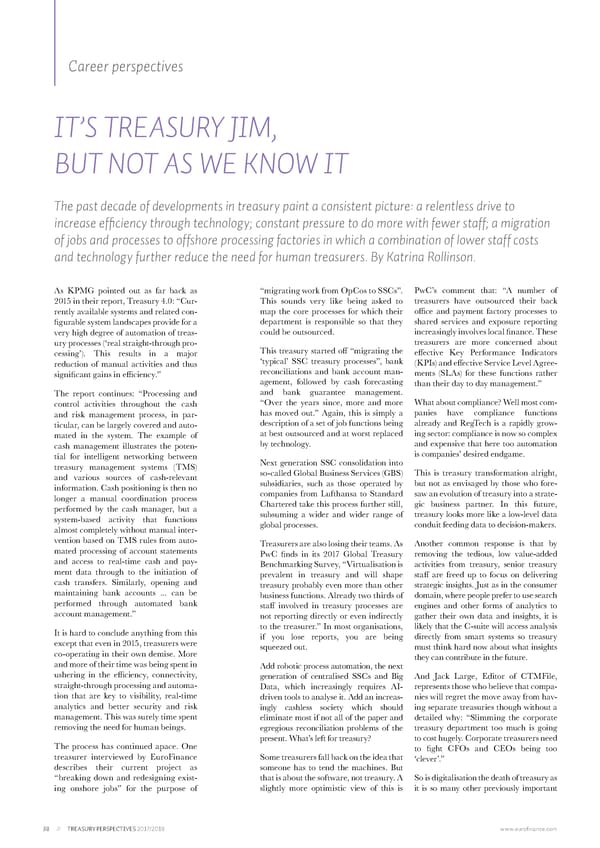Career perspectives IT’S TREASURY JIM, BUT NOT AS WE KNOW IT The past decade of developments in treasury paint a consistent picture: a relentless drive to increase efficiency through technology; constant pressure to do more with fewer staff; a migration of jobs and processes to offshore processing factories in which a combination of lower staff costs and technology further reduce the need for human treasurers. By Katrina Rollinson. As KPMG pointed out as far back as “migrating work from OpCos to SSCs”. PwC’s comment that: “A number of 2015 in their report, Treasury 4.0: “Cur- This sounds very like being asked to treasurers have outsourced their back rently available systems and related con- map the core processes for which their office and payment factory processes to figurable system landscapes provide for a department is responsible so that they shared services and exposure reporting very high degree of automation of treas- could be outsourced. increasingly involves local finance. These ury processes (‘real straight-through pro- treasurers are more concerned about cessing’). This results in a major This treasury started off “migrating the effective Key Performance Indicators reduction of manual activities and thus ‘typical’ SSC treasury processes”, bank (KPIs) and effective Service Level Agree- significant gains in efficiency.” reconciliations and bank account man- ments (SLAs) for these functions rather agement, followed by cash forecasting than their day to day management.” The report continues: “Processing and and bank guarantee management. control activities throughout the cash “Over the years since, more and more What about compliance? Well most com- and risk management process, in par- has moved out.” Again, this is simply a panies have compliance functions ticular, can be largely covered and auto- description of a set of job functions being already and RegTech is a rapidly grow- mated in the system. The example of at best outsourced and at worst replaced ing sector: compliance is now so complex cash management illustrates the poten- by technology. and expensive that here too automation tial for intelligent networking between is companies’ desired endgame. treasury management systems (TMS) Next generation SSC consolidation into and various sources of cash-relevant so-called Global Business Services (GBS) This is treasury transformation alright, information. Cash positioning is then no subsidiaries, such as those operated by but not as envisaged by those who fore- longer a manual coordination process companies from Lufthansa to Standard saw an evolution of treasury into a strate- performed by the cash manager, but a Chartered take this process further still, gic business partner. In this future, system-based activity that functions subsuming a wider and wider range of treasury looks more like a low-level data almost completely without manual inter- global processes. conduit feeding data to decision-makers. vention based on TMS rules from auto- Treasurers are also losing their teams. As Another common response is that by mated processing of account statements PwC finds in its 2017 Global Treasury removing the tedious, low value-added and access to real-time cash and pay- Benchmarking Survey, “Virtualisation is activities from treasury, senior treasury ment data through to the initiation of prevalent in treasury and will shape staff are freed up to focus on delivering cash transfers. Similarly, opening and treasury probably even more than other strategic insights. Just as in the consumer maintaining bank accounts ... can be business functions. Already two thirds of domain, where people prefer to use search performed through automated bank staff involved in treasury processes are engines and other forms of analytics to account management.” not reporting directly or even indirectly gather their own data and insights, it is It is hard to conclude anything from this to the treasurer.” In most organisations, likely that the C-suite will access analysis except that even in 2015, treasurers were if you lose reports, you are being directly from smart systems so treasury co-operating in their own demise. More squeezed out. must think hard now about what insights and more of their time was being spent in they can contribute in the future. Add robotic process automation, the next ushering in the efficiency, connectivity, generation of centralised SSCs and Big And Jack Large, Editor of CTMFile, straight-through processing and automa- Data, which increasingly requires AI- represents those who believe that compa- tion that are key to visibility, real-time driven tools to analyse it. Add an increas- nies will regret the move away from hav- analytics and better security and risk ingly cashless society which should ing separate treasuries though without a management. This was surely time spent eliminate most if not all of the paper and detailed why: “Slimming the corporate removing the need for human beings. egregious reconciliation problems of the treasury department too much is going The process has continued apace. One present. What’s left for treasury? to cost hugely. Corporate treasurers need treasurer interviewed by EuroFinance to fight CFOs and CEOs being too Some treasurers fall back on the idea that ‘clever’.” describes their current project as someone has to tend the machines. But “breaking down and redesigning exist- that is about the software, not treasury. A So is digitalisation the death of treasury as ing onshore jobs” for the purpose of slightly more optimistic view of this is it is so many other previously important 38 // TREASURY PERSPECTIVES 2017/2018 www.eurofinance.com
 Who's Running the Treasury? Page 37 Page 39
Who's Running the Treasury? Page 37 Page 39